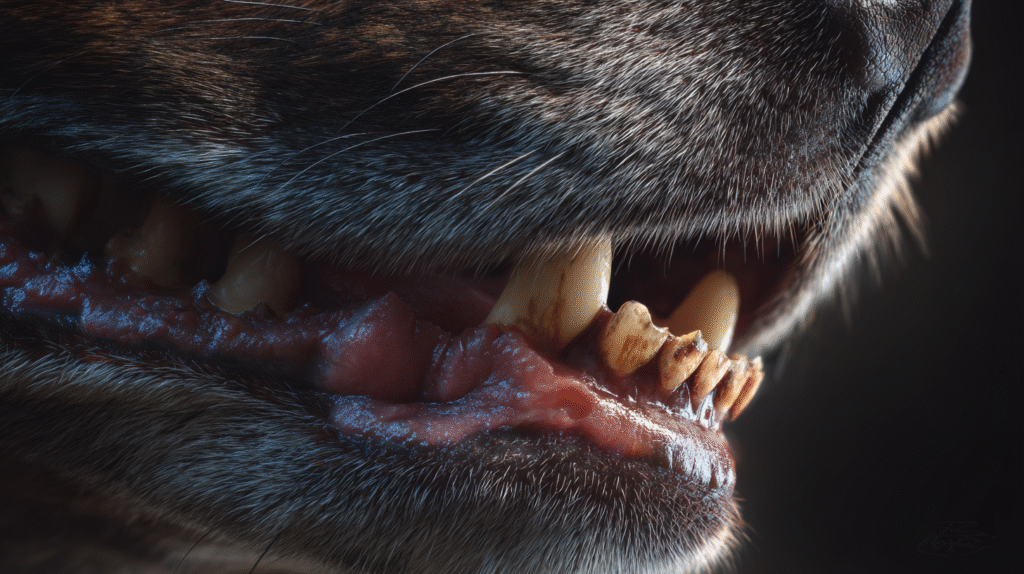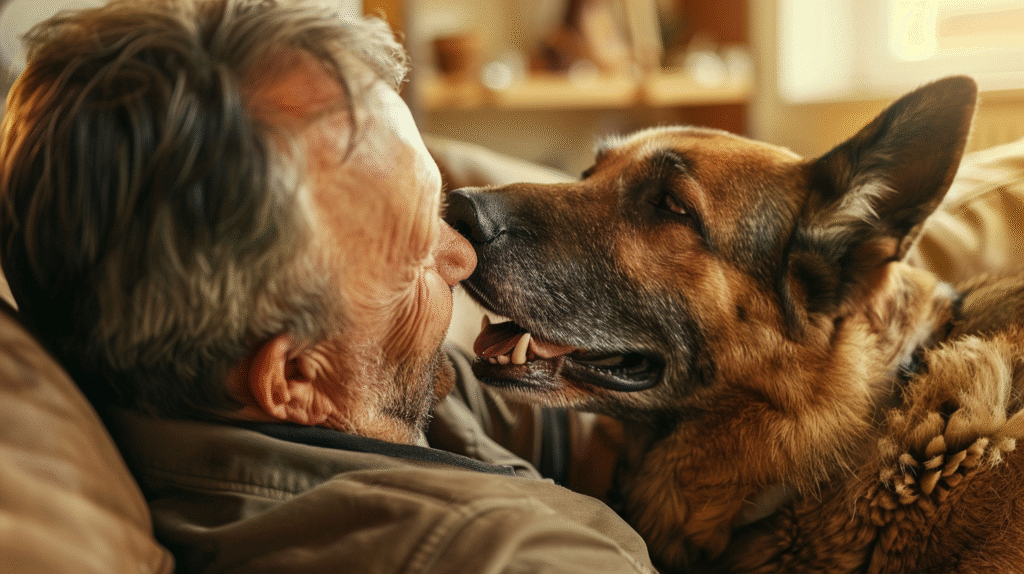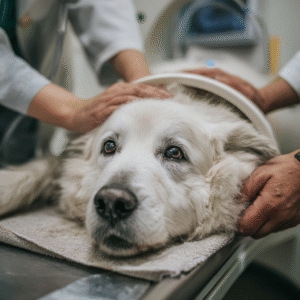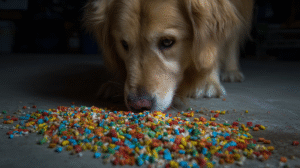A Silent Threat: How Dental Disease Affects Your Dog’s Entire Body
Is your dog’s bad breath more than just a minor annoyance?
Many owners don’t realize the significant dangers of poor dental health in dogs, which often begin with the subtle early signs of gum disease in dogs.
Understanding the serious link between dog dental health and heart disease makes it clear why learning how to prevent plaque buildup on dog’s teeth is so crucial.
Fortunately, there are many effective and natural ways to clean dogs teeth at home to protect their overall well-being.
Table of Contents
- What Exactly is Canine Dental Disease?
- The Early Signs of Gum Disease in Dogs You Can’t Ignore
- Uncovering the Hidden Dangers of Poor Dental Health in Dogs
- Proactive Care: How to Prevent Plaque Buildup on Dog’s Teeth
- Exploring Natural Ways to Clean Dogs Teeth at Home
- Vidatox: A Supportive Role in Managing Oral Inflammation
- Frequently Asked Questions About Your Dog’s Dental Health
What Exactly is Canine Dental Disease?
Canine dental disease, also known as periodontal disease, is an infection and inflammation of the gums and bone surrounding a dog’s teeth.
It all starts with plaque—a soft, sticky film of bacteria that constantly forms on the teeth.
If this plaque is not removed, it hardens into tartar (also called calculus) within a few days. Tartar is a hard, yellow-brown deposit that sticks firmly to the teeth and is much more difficult to remove.
The presence of tartar irritates the gums, leading to inflammation known as gingivitis.
This is the first stage of dental disease and the only one that is reversible.
Left untreated, it progresses to periodontitis, which causes permanent damage to the supportive tissues around the teeth, leading to pain and tooth loss.
This progression highlights the true dangers of poor dental health in dogs.
The Early Signs of Gum Disease in Dogs You Can’t Ignore
One of the greatest challenges with dental disease is that dogs are masters at hiding pain. Therefore, it’s up to you as a pet parent to be vigilant.
Catching the problem early is key to preventing severe complications.
You must regularly check your dog’s mouth for the early signs of gum disease in dogs.
Look for these specific warning signs:
- Persistent Bad Breath (Halitosis): This is often the very first clue that owners notice.
- Red, Swollen, or Bleeding Gums: Healthy gums are a uniform pink color; redness indicates inflammation.
- Yellow-Brown Crust (Tartar) on Teeth: Especially noticeable on the back molars.
- Reluctance to Eat Hard Food or Chew on Toys: This can indicate a sore mouth.
- Pawing at the Mouth or Face: A clear sign of oral discomfort.
- Drooling More Than Usual: Sometimes the drool may be tinged with blood.
Noticing any of these early signs of gum disease in dogs warrants an immediate conversation with your veterinarian.

Uncovering the Hidden Dangers of Poor Dental Health in Dogs
While bad breath and potential tooth loss are serious issues, the true dangers of poor dental health in dogs extend far beyond the mouth.
This is a systemic issue, meaning it can affect your dog’s entire body.
The bacteria that thrive in the plaque and tartar on your dog’s teeth can easily enter the bloodstream through inflamed, bleeding gums. Once in circulation, these harmful bacteria can travel to and establish infections in vital organs.
This is where the direct link between dog dental health and heart disease becomes critically important. Bacteria can attach to the heart valves, leading to a dangerous condition called endocarditis.
Furthermore, the kidneys and liver are also at high risk.
These organs work tirelessly to filter the blood, and a constant influx of bacteria from the mouth can lead to inflammation, infection, and a decrease in organ function over time.
This clear link between dog dental health and heart disease, as well as other organ damage, underscores why dental care is a cornerstone of your dog’s overall health.
Ignoring oral hygiene exposes your pet to some of the most severe dangers of poor dental health in dogs.
Proactive Care: How to Prevent Plaque Buildup on Dog’s Teeth
The absolute best approach to dental health is prevention. Knowing how to prevent plaque buildup on dog’s teethcan save your pet from pain and protect their long-term health.
Daily action is the most effective strategy.
The gold standard for preventing dental disease is daily tooth brushing.
Using a toothbrush and toothpaste specifically designed for dogs is the most effective way to remove the soft plaque before it hardens into tartar.
This simple habit is the foundation of how to prevent plaque buildup on dog’s teeth.
In addition to brushing, providing safe dental chews and toys can help scrape plaque off the teeth through mechanical action.
There are also specific dental diets formulated with a kibble size and texture that helps scrub the teeth as your dog eats.
Knowing how to prevent plaque buildup on dog’s teeth is the most powerful tool you have against this common disease.

Exploring Natural Ways to Clean Dogs Teeth at Home
Beyond brushing, many pet owners are interested in other supportive measures. There are several natural ways to clean dogs teeth at home that can complement your daily routine.
These methods can help maintain a healthier oral environment.
- Raw Carrots or Apple Slices: The crunchy texture of these healthy snacks can help scrape away plaque. Always be sure to remove apple seeds, which are toxic.
- Coconut Oil: Some studies suggest that coconut oil has natural antibacterial properties. You can apply a small amount to your dog’s teeth with your finger or a brush.
- Dental Water Additives: There are many natural, enzyme-based water additives that can help reduce bacteria in the mouth with every sip your dog takes.
- Kelp Supplements: Certain types of kelp have been shown to help reduce plaque and tartar buildup when added to a dog’s food.
Exploring these natural ways to clean dogs teeth at home can be a great part of your preventative strategy. However, it is vital to remember they are a supplement to, not a replacement for, daily brushing and professional veterinary care. Always discuss new supplements with your vet.
Vidatox: A Supportive Role in Managing Oral Inflammation
When a dog is suffering from gingivitis, the inflammation and discomfort can be significant.
The gums become red, swollen, and painful, which is one of the key dangers of poor dental health in dogs.
While veterinary cleaning is essential to remove the source of the problem (tartar), supportive care can play a crucial role in managing the symptoms and improving your dog’s comfort.
This is where a natural remedy like Vidatox can be a valuable complementary therapy.
The primary benefit of Vidatox in this context is its powerful anti-inflammatory action.
The pain and tissue damage of gum disease are driven by the body’s inflammatory response to bacteria.
By helping to modulate and calm this inflammation, Vidatox can directly address the root of the discomfort in the gums.
This can help reduce the swelling and redness associated with the early signs of gum disease in dogs. Furthermore, Vidatox is known for its analgesic (pain-relieving) properties.
A sore mouth can make a dog reluctant to eat, play, or even be touched.
By providing natural pain relief, Vidatox can significantly improve your dog’s quality of life as they recover from dental procedures or as part of a long-term management plan for chronic oral sensitivity.
It is absolutely essential to understand that Vidatox does not remove plaque or tartar and is not a substitute for the mechanical cleaning of brushing or professional veterinary care.
Instead, think of Vidatox as a supportive tool in your arsenal.
When used under the guidance of your veterinarian, Vidatox can help manage the painful inflammation of gingivitis, making your dog more comfortable and supporting the healing of their oral tissues.
This focus on managing inflammation from the inside out makes Vidatox a logical supportive measure in a comprehensive dental health plan.

Frequently Asked Questions About Your Dog’s Dental Health
Q: Is anesthesia for dental cleaning safe for my dog? A: While any anesthetic procedure has risks, modern veterinary anesthesia is very safe. Vets perform pre-anesthetic bloodwork to ensure your dog is a good candidate. Anesthesia is necessary for a thorough cleaning under the gum line and to take dental X-rays, which are essential for identifying problems you can’t see.
Q: How often does my dog need a professional dental cleaning? A: This varies greatly depending on the dog’s breed, age, and home care routine. Small breeds are often more prone to dental issues. Your veterinarian will recommend a schedule based on your dog’s specific oral health at their annual checkup.
Q: Can I just scrape the tartar off my dog’s teeth myself? A: No, this is not recommended. This is called anesthesia-free dentistry and it is largely cosmetic and can be dangerous. It doesn’t clean below the gumline, which is where the real disease occurs, and using sharp tools on an awake pet can easily injure their mouth or cause them to become fearful.
Q: What is the best dental chew for my dog? A: Look for chews that are firm enough to be effective but soft enough to not risk fracturing a tooth. A good rule of thumb is if you can’t make an indent in it with your thumbnail, it might be too hard. Products with the Veterinary Oral Health Council (VOHC) seal of approval have been tested for their effectiveness.




